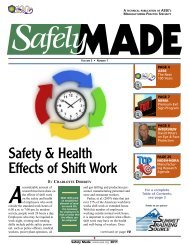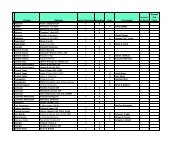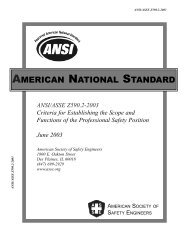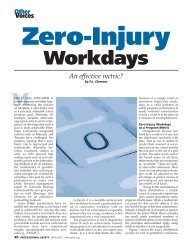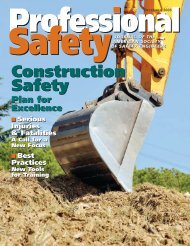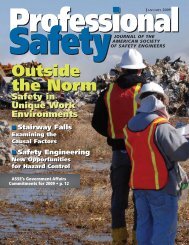Safety 2008 - ASSE - American Society of Safety Engineers
Safety 2008 - ASSE - American Society of Safety Engineers
Safety 2008 - ASSE - American Society of Safety Engineers
Create successful ePaper yourself
Turn your PDF publications into a flip-book with our unique Google optimized e-Paper software.
The first stepin integratingergonomicconsiderations intothe lab environmentis to recognizehazards that stressthe body andare associatedwith ergonomicrelatedinjuries.30 PROFESSIONAL SAFETY AUGUST <strong>2008</strong> www.asse.orger’s shoulders when using thebath. Baths may be appropriatelyplaced on a lower shelf toreduce shoulder stress. To reduceawkward wrist posture, considerbaskets with handles or curvedergonomic tools that reduceulnar deviation <strong>of</strong> the wrist.LiftingLifting hazards in the laboratoryinclude moving compressedgas cylinders; movingequipment; removing largebottles <strong>of</strong> chemicals from cabinetsor shelves; changing wastecontainers; and receiving newsamples or equipment. Thus,each laboratory should beassessed for lifting hazards. Ifgas cylinders are moved manually,consider placing them on awheeled cart. Based on the frequency and weight <strong>of</strong>lifts, consider whether mechanical lifting devices areappropriate. When manual lifting is required, ensurethat workers are trained in proper lifting techniquesand reinforce these behaviors. Identify couplingissues from lifting while wearing poor-fitting gloves.If this is an issue, identify chemically compatiblegloves that fit properly and facilitate a good grip.ComputersComputers are common in labs. Keyboardsshould be placed so the worker’s elbows are atapproximately a 90º angle. Monitors should beplaced directly in front <strong>of</strong> the worker with the top <strong>of</strong>the monitor just below eye level to promote neutralneck posture. Avoid placing the computer in a positionwhere glare from the window reflects on themonitor screen or in the worker’s eyes (Anshel,2006, p. 21). The mouse should also be within easyreach. If computer use is <strong>of</strong> short duration, standingposture is acceptable. A floor mat can promote comfortand reduce fatigue. For prolonged use, a sittingworkstation is recommended.Avoiding Ergonomic Injury in the LabImplementing a solid ergonomic program in thelab requires time, resources and management commitment.This commitment will strengthen the lab’s safetyculture—employees will recognize the importance<strong>of</strong> their well-being to management and the business.Involve employees in the hazard recognitionprocess. Identify priority actions based on potentialrisk <strong>of</strong> injury, worker complaints and the potentialseverity <strong>of</strong> injury. Review OSHA logs and first-aidreports to assess trends in worker complaints. Encourageearly symptom reporting and provideprompt medical management as well as ergonomicintervention when required.Another positive step is the development <strong>of</strong> awritten ergonomic program that defines scope andresponsibility. A written action plan that establishestimelines and assigns responsibility for each projectis also important. When making decisions anddeveloping the action plan, evaluate options, prioritizeand select the best corrective or preventiveaction for the individual laboratory operation.ConclusionLaboratory ergonomics is based on the samehuman factors/ergonomic principles found in anywork environment. A detailed search for data onergonomic-related injuries associated with the laboratoryenvironment yielded no results. Researchassociated with laboratory ergonomics was limitedto the NIOSH/Duke University pipette study.In the author’s experience, symptoms have beenreduced or abated when the ergonomic risk reductionstrategies described in this article have beenimplemented. Understanding the concepts <strong>of</strong> generalergonomics and how they translate to the lab environmentprovides the foundation for a solidergonomic program. A strong ergonomic programwill protect lab workers and benefit the company.This area also presents an opportunity for furtherresearch to validate control methods specific to thelaboratory environment. ReferencesAnshel, J.R. (1998). Visual ergonomics in the workplace. Bristol,PA: Taylor & Francis.Anshel, J.R. (2006, Aug.). Visual ergonomics in the workplace:Improving eyecare and vision can enhance productivity. Pr<strong>of</strong>essional<strong>Safety</strong>, 51(8), 20-25.Asundi, K.R., Bach, J.M. & Rempel, D.M. (2005, Spring).Thumb force and muscle loads are influenced by the design <strong>of</strong> amechanical pipette and by pipetting tasks. Human Factors, 47(1),67-76.David, G. & Buckle, P. (1997). A questionnaire survey <strong>of</strong> theergonomic problems associated with pipettes and their usagewith specific reference to work-related upper limb disorders.Applied Ergonomics, 28, 257-262.Grandjean, E. (1988). Fitting the task to the man (4th ed.). NewYork: Taylor & Francis.Humantech Inc. (1996). Laboratory ergonomics manual. AnnArbor, MI: Author.Humantech Inc. (2000). Applied ergonomics laboratory workbook.Ann Arbor, MI: AuthorJanicak, C.A. (2004, Jan.). Preventing HAVS in the workplace:Identifying workplace risk on hand-arm vibration syndrome.Pr<strong>of</strong>essional <strong>Safety</strong>, 49(1), 35-40.Kroemer, K.H., Kroemer, H.B. & Kroemer-Elbert, K.E. (2001).Ergonomics: How to design for ease and efficiency (2nd ed.). UpperSaddle River, NJ: Prentice Hall.Lu, M.L. & Sudhakaran, S. (2005, March 25). Evaluation <strong>of</strong>the effectiveness <strong>of</strong> a redesigned pipette for reducing the risk factorsfor musculoskeletal disorders. Applied Ergonomics: 2005Ergonomics Conference Presentation. Retrieved April 26, 2007, fromhttp://www.appliedergo.org/casestudies/2005/pr<strong>of</strong>179.asp.NIOSH & Cal/OSHA. (2004). Easy ergonomics: A guide to selectingnonpowered hand tools (NIOSH Publication No. 2004-164). Washington,DC: U.S. Department <strong>of</strong> Health and Human Services,Centers for Disease Control and Prevention, Author.Plog, B.A., Niland, J. & Quinlan, P. (1996). Fundamentals <strong>of</strong>industrial hygiene (4th ed.). Itasca, IL: National <strong>Safety</strong> Council.Putz-Anderson, V. (1988). Cumulative trauma disorders: A manualfor musculoskeletal diseases <strong>of</strong> the upper limbs. Tampa, FL:Informa Healthcare.Ramos Vieira, E. & Kumar, S. (2004, June). Working postures:A literature review. Journal <strong>of</strong> Occupational Rehabilitation, 14(2), 143-159.Sanders, M.S. & McCormick, E.J. (1993). Human factors inengineering and design (7th ed.). New York: McGraw-Hill.






